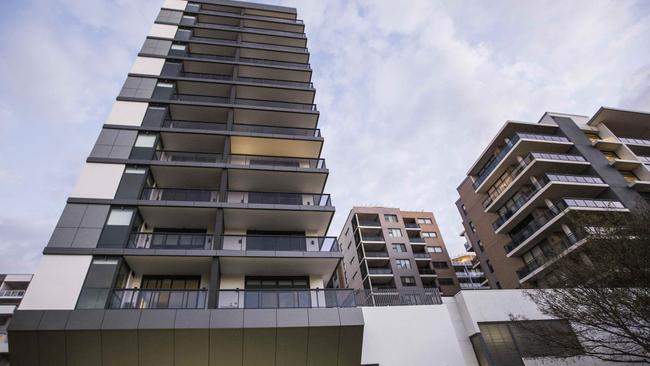Taxation helped make the building crisis

Some days walking the Royal Mile was like leaving the MCG after the Anzac Day game. The place is mobbed by gawkers like me. Everyone’s there partly there for the Scottishness of it all – the history, the bagpipe buskers, the overpriced cashmere scarves, the whisky and even the appalling haggis – but we all mainly spent our time admiring the rows of magnificent 500-year-old buildings and castles, most of which look like they’ll be there for another 500 years.
I returned to Australia to news of 20-year-old buildings falling down, or covered in plastic cladding that, if someone strikes a match nearby, will incinerate the occupants.
The contrast couldn’t be greater, not just between Edinburgh and Australia, but between past building standards in general and modern ones.
There are plenty of 100-year-old buildings in Australia that probably will be still standing in another 400 years, but now construction has become part of the disposable society. Landfill is being increasingly being taken up by the results of demolition, not just clothes and household garbage.
Forget about 500 years, or even 100 years. Not one of the buildings that have been chucked up in Australia in the past couple of decades will be there in 50 years.
This dawning realisation – not to mention the actual cracks, of course – is causing a national building crisis, partly to do with insurance and partly to do with duckshoving over who’s going to pay for remediation.
The flammable cladding problem isn’t, or at least shouldn’t be, a surprise. CSIRO first sounded the alarm on this back in 1995 and was ignored, and even when the outside walls of Melbourne’s Lacrosse Tower burst into flames in 2014 nothing was done.
When the Grenfell Tower fire in London killed 72 people, an inquiry was finally set up, but it has quickly emerged that there was more to Australia’s problem with shoddy housing than flammable cladding.
The Opal Tower in Sydney had to be evacuated last year after cracks started appearing, and likewise with the Mascot Towers in June. The owners of that one had been battling structural flaws like faulty gas meters and leaks since 2011, attributed to “poor sealing practice at construction and in the construction joists”.
It’s clear that, in general, builders and the surveyors responsible for certifying the buildings are under huge pressure to keep costs down and agree to shoddy materials and corners being cut.
Certification used to be done by council employees. But the privatisation of surveying, such that those issuing the certificates are employed and paid by those being certified, has resulted in a fundamental conflict of interest, more dangerous than any in the financial services industry.
State governments also have a conflict of interest because of the stamp duty and other taxes they collect every time an apartment block is built.
There is no legal builders’ warranty for residential buildings more than three storeys high, after a 2014 High Court ruling that builder Multiplex owed no duty of care to residents of a defective tower in Sydney’s Chatswood.
Professional indemnity insurance for surveyors and architects is drying up because it hasn’t been profitable for years.
And politicians are queuing up to go on TV and shake their heads over the dreadfulness of it all, and to promise that their number one concern is their jobs, er … sorry, I mean peoples’ safety.
Underlying the crisis are two things: deregulation and Australia’s practice of build-to-sell rather than build-to-rent.
In other countries apartments are built by institutions, usually pension funds and endowments, which then rent them out. They make sure they are well built, because these are long term investors who want the buildings to last a long time.
Australia’s apartment blocks are built by short-term speculators (we call them “developers”) who plan to sell the apartments one at a time to individual investors. The aim is to sell each of them before they are built, so the profit is underwritten. After they have been sold off the plan, any saving on the cost of building them is pure cream to the developer
The speculator-developers have no ongoing interest in the dwellings beyond maximising the profit and moving onto the next one. The banks won’t lend them money, so the projects are financed with expensive mezzanine debt that put further pressure on other costs.
All things considered, it’s not at all surprising that they use cheap concrete and put plastic on the outside. The incentives push them that way, and the inspectors and regulators don’t stop them.
And the reason the rent-to-sell system exists in Australia is tax: negative gearing encourages individual investors to buy the apartments, and prohibitive land taxes discourage institutions from investing in them, or in residential real estate at all.
There is no asset allocation to residential real estate in Australian super funds’ portfolios.
In other words, the reason so many of Australia’s apartment buildings are falling down, or are covered in cheap flammable cladding, is tax.
And Labor’s plan to only allow negative gearing on new buildings would have made matters worse, not better.
Better regulation is necessary. And preferably it would be government or council run, with no conflicts of interest … that is, once the politicians have worked out who among them is going to slug taxpayers to fix up the buildings. Is it federal, state or both?
But the problem won’t be properly fixed until the tax system is fixed, so that those who build the apartments own them and the rent them out.
And that means ending negative gearing and reforming land tax.
Alan Kohler is Editor in Chief of InvestSMART



I recently spent some time in Edinburgh, which is very beautiful and full of tourists. Why is it beautiful and what are the tourists doing there? It’s because the buildings are really old.